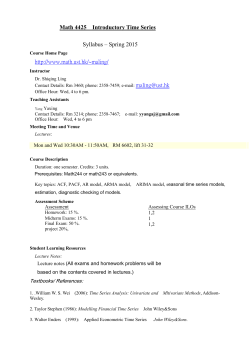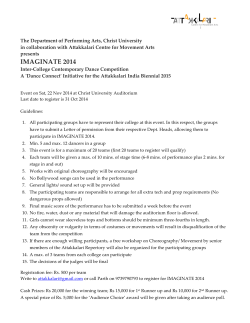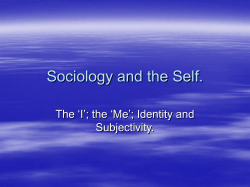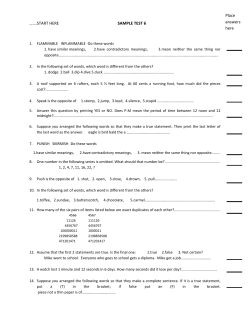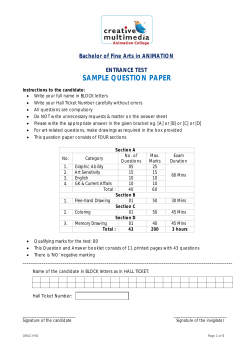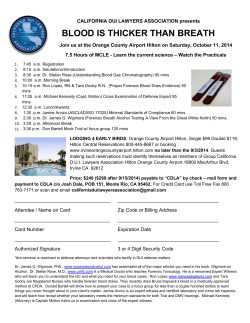
ELEC 1020 Media Production: Technology and Design Lecture 2
ELEC 1020 Media Production: Technology and Design Lecture 2 Prof. James She (james.she@ust.hk) 1 Announcement • Lab 1 next Monday @ 3119 in the Lab. building • TAs will show you where it is (after the lecture if necessary) • Don’t come late 2 Announcement – Course website (www.ee.ust.hk/elec1020) (course.ee.ust.hk/elec1020) 3 Last lectures 4 Outcomes from this lecture 1. Digital Media 2. Marketing 3. Design Principles 5 Recall: What’s Media? 6 In-class Activity (Group, 5 mins): What’s Media? Requirements/Constraints of • Production: 1-2 best answer • Delivery: 1-2 best answer • Presentation: 1-2 best answer Medium 1. 2. 3. Content 1. 2. 3. Outdoor Billboard Media 7 Outcomes from this lecture 1. Digital Media 2. Marketing 3. Design Principles 8 What is Marketing? Marketing is 1. “the process of performing market research, selling products and/or services to customers and promoting them via advertising to further enhance sales.” – wikipedia.com 2. “the activity, set of institutions, and processes for creating, communicating, delivering, and exchanging offerings that have value for customers, clients, partners, and society at large.” – American Marketing Association and more… 9 Type of Marketing: Marketing is 1. One-to-one marketing 2. Mass marketing (1-to-all) 3. Word-of-mouth marketing (Viral marketing) 10 One-to-one Marketing: • promote messages/ services/ products to one customer at a time. • identify and then meet their individual needs. (personalized) • aim to repeat this many times with each customer, such that powerful lifelong relationships are forged. e.g., a sale-person, a personalized letter, a marketing phone call, etc. 11 Mass Marketing • to sell through persuasion of a product/ idea/ service to a wide audience. • to broadcast a message that will reach the largest number of people. e.g., radio, television and newspapers as the medium used to reach this broad audience. 12 Word-of-Month Marketing: • a form of promotion (oral/written/visual), in which satisfied customers tell other people how much they like an idea, product, service, business or event. • a more credible form of advertising because people who may not gain anything personally by promoting something put their reputations on the line every time they make a recommendation. e.g., your friends, your families, gmail, etc. (from “The impact of word-of-mouth marketing: a McKinsey report”) http://www.freshnetworks.com/blog/2010/04/assessingthe-impact-of-word-of-mouth-marketing-a-mckinseyreport/ 13 In-class Activity (Individual - 5 mins): Marketing yourself to be remembered You Talk to as many as you can… • Your Name: • Dept: • Interests: • Something special of yourself Others How many could be remember? • • Get the name Able to describe him/her 14 Why Digital Media? 15 Online/Digital Marketing More effective - recalled your self-introduction to your fellow classmates - lower-cost, faster, bigger coverage, mass customization, etc. - the power of Internet, mobile networks and social networks (email, web, sms, fax, etc.) - the power of digital media (not just a simple text for marketing, but with Multimedia?!) 16 Example of Digital Media • • • • • • • • • • Text in Web/Hypertext (links) Audio (Surround sounds) Image Animation Video (3D) Email, Internet, Social Media and Networks Mobility and Location (from your smart phones) Gesture? Smells? Or more 17 Outcomes from this lecture 1. Digital Media 2. Marketing 3. Design Principles 18 Design… …Principles 19 Design Principles Creating the right digital media Anyone know how to create a powerpoint slide? but are you sure that you could make a good one? http://www.youtube.com/watch?v=lpvgfmEU2Ck 20 Design Principles Maximize the marketing impacts A piece of marketing message from a company, individual or charity The multimedia marketing thing you designed The perceived message by a group of audience Is the perceived message 1. correct? 2. clear and complete? 3. reaching the right group of audience? 4. covering enough audience? 5. sticky to the audience (i.e., people get impressed and remember)? The more ‘Yes’ above, the audience have more perceived impacts. 21 Design Principles A. Understanding the original marketing message 1. what is the contextual meanings? 2. any other cultural meanings? 3. from who (e.g., a charity)? to who (e.g., student)? 4. what impression/ image is needed? 5. how long is aimed to last? 6. etc. 22 Design Principles B. Knowing more about your targeted audience 1. what are the environments they perceive the message? 2. what are their ages? and demographics? 3. what are the common languages? 4. their cultures? 5. their educational backgrounds? 6. etc. 23 Design Principles C. Identifying the right digital media and multimedia technologies 1. Making it artistically and technically looking good/pretty? 2. Is it the right media type (e.g., text, song, photo, video, etc.) and the form of presentation/delivering (e.g., email? facebook?) 3. the perceptual meanings (e.g., visually) aligned to the meanings of the original message? 4. Is the media effect (e.g., loudness, tones, styles) aligned to the original message? 5. Is it a right mix of various digital media? 6. etc. 24 Design Principles Imagining and Engineering 1. Come up with a few sketches of design concepts (e.g., a visual story, a static image, an audio clip) that meet A + B + C 2. Refine or combine these 3. Implement within the constraints in terms of time, manpower, budget, space, etc. 4. Go back to 2. or 1. until you feel good! 25 Design Principles A Good Example of Bad Design: British Doors “…The door on the left tells us to push, but is locked shut for some strange reason. The one on the right does open but the handle tells us to pull. Doors are not new technology. You’d think people would have figured out how to design their function and form to facilitate use. Not always.” (from http://www.cashewman.com/2009/12/a-good-example-of-baddesign-british-doors/) 26 - End of Lecture 2 - 27
© Copyright 2025

